| Author |
 Topic Topic  |
|
xequte
    
38939 Posts |
 Posted - Feb 02 2014 : 22:03:18 Posted - Feb 02 2014 : 22:03:18


|
250 demo projects are included with ImageEn, and can also be accessed at:
http://www.imageen.com/demos/
But we also welcome users to submit other demos that might be useful, and also link to their own applications that have been created with ImageEn.
Please upload your demo by posting a reply and clicking "attach a photo or zip" (full source demos only, with an EXE). When linking to a demo or application please advise whether it is full source, free or $$$. If possible, also include a screenshot.
Many more demos are available with Adirondack's ImageEn E-book:
http://www.imageen.com/ebook/
Nigel
Xequte Software
www.xequte.com
nigel@xequte.com
|
|
|
xequte
    
38939 Posts |
 Posted - Feb 02 2014 : 22:06:47 Posted - Feb 02 2014 : 22:06:47


|
AirPhoto SE
by The Unkelbach Valley Software Works
Full Source and Installer Exe
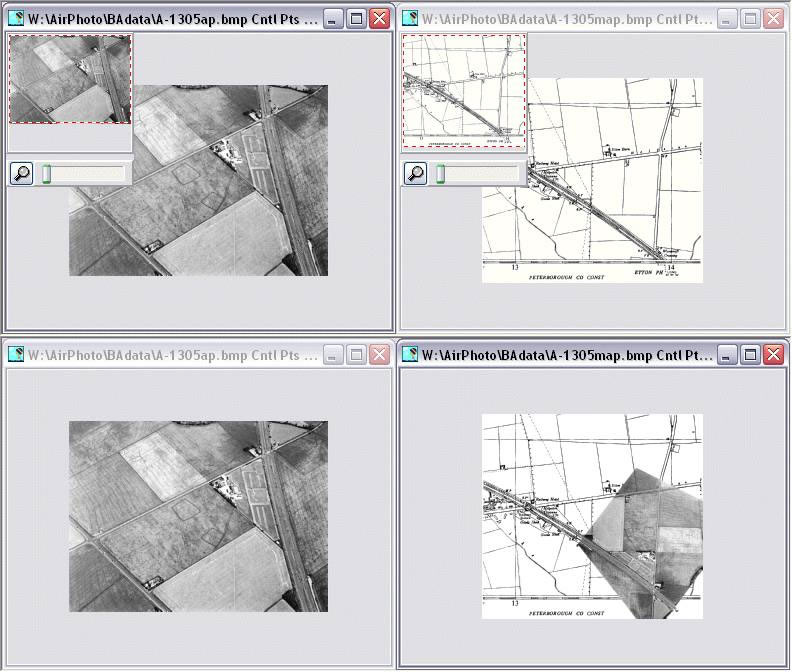
AirPhotoSE is a simple program for the rectification of perspective distortion in aerial photographs. It requires an image and a map along with a set of matching points (control points) for each. A single non-aerial image may also be used and corrected arbitrarily to create a new image of the same size.
Download: www.ImageEn.com/files/Other/AirSE.zip
Nigel
Xequte Software
www.xequte.com
nigel@xequte.com |
 |
|
|
xequte
    
38939 Posts |
|
|
w2m
   
USA
1990 Posts |
|
|
w2m
   
USA
1990 Posts |
|
|
spetric
  
Croatia
308 Posts |
 Posted - Mar 14 2014 : 04:57:09 Posted - Mar 14 2014 : 04:57:09


|
Here is a source code for binding Lua with ImageEn. Demo exe included.
More details in readme.txt
Screen:
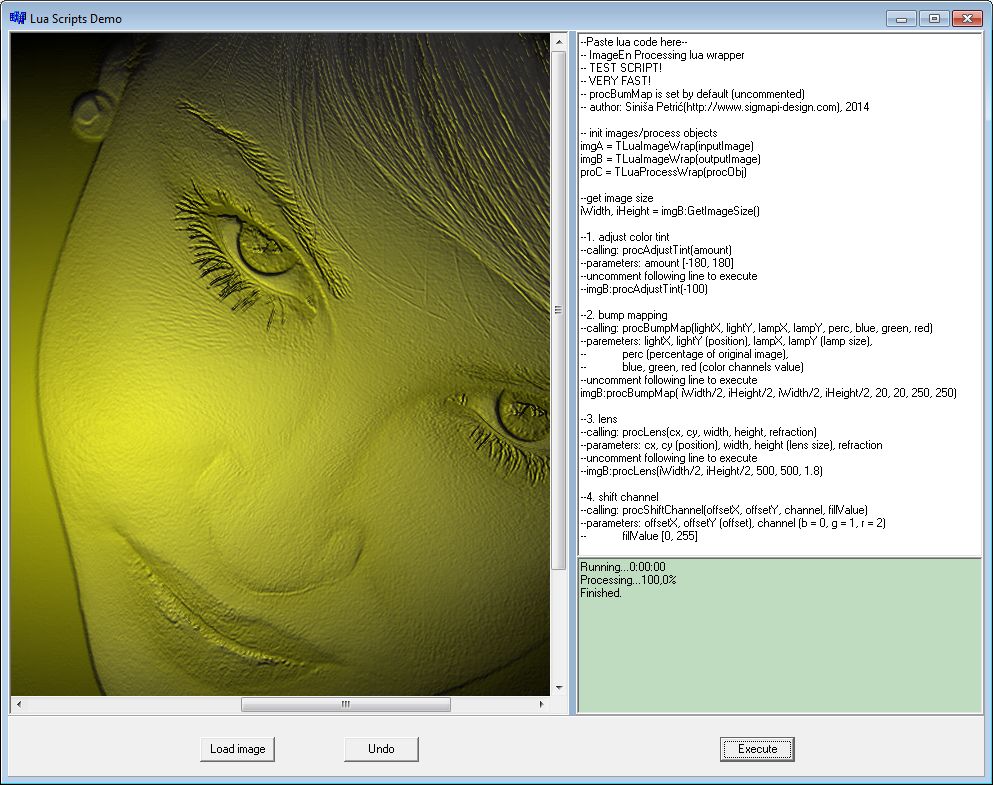
Code and demo: www.ImageEn.com/files/Other/spectric_lua_demo.zip
There are few scripts in scripts directory. Open script in notepad,
past and copy content into memo field and press execute.
Edit: you can modify code inside memo field (set various params etc...) and press execute to see your changes. |
 |
|
|
w2m
   
USA
1990 Posts |
|
|
w2m
   
USA
1990 Posts |
 Posted - Apr 10 2014 : 11:04:02 Posted - Apr 10 2014 : 11:04:02


|
Threaded Image Processing
by William Miller Adirondack Software
Full Source
Compiled with Delphi XE4 (Requires Delphi 2010 or higher and ImageEn 4.3.0 or higher with iexHelperFunctions)
Lines of Code: 1,481
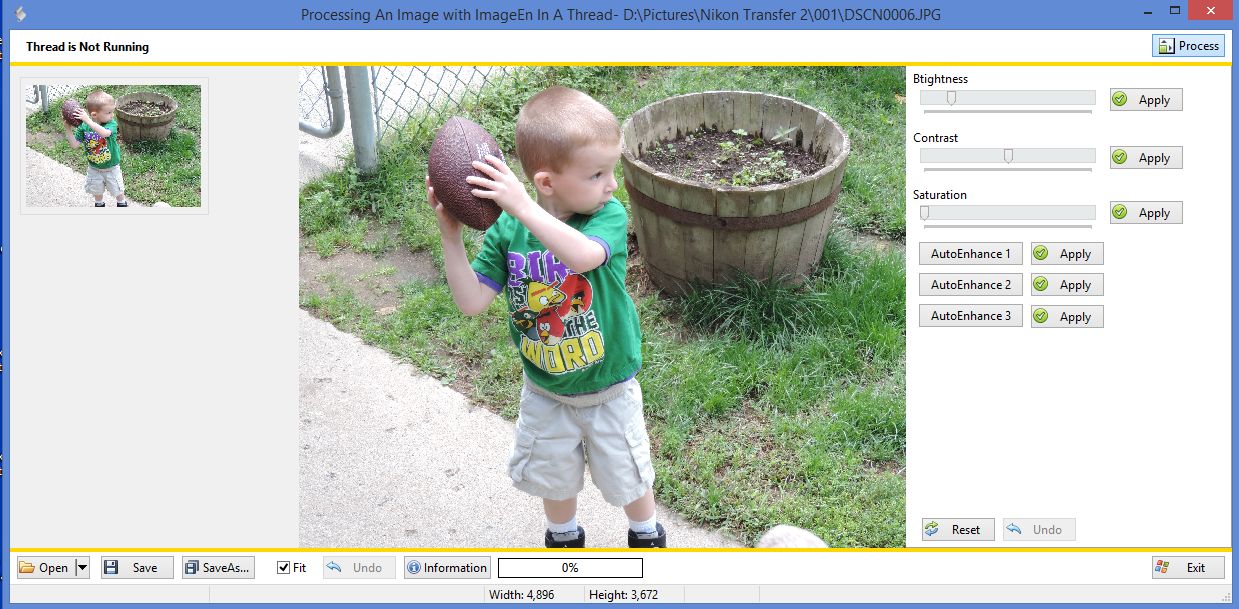
This demo does image processing in a secondary thread. Trackbars can be used to change image brightness, contrast, and saturation in a secondary thread. Before each processing event the a copy of the original image is used for the processing to provide the optimum result. AutoImageEnhance 1, 2 and 3 are a one step process that does not use trackbars, but consume a significant amount of time so these are threaded as well. The thread system is designed to easily be add other image processing procedures. The demo also includes Undo and Reset (all undo) and Most Recent Files (MRU) image opening as well as Save and SaveAs. The thread class can easily be copied and implemented in your own application with for your specific processing needs. You must add some code to the thread for your own processing procedure using techniques used in the thread for new procedures.
Image processing is very fast as the trackbars operate on a thumbnail of the full image. "Apply" buttons for each task is also provided to apply the previewed effect to the full image which is also run in the secondary thread. The thumbnail preview as well the full image effects can be undone.
Download: www.ImageEn.com/files/Other/w2m_threadedprocessing.zip
William Miller
Adirondack Software & Graphics
Email: w2m@frontiernet.net
EBook: http://www.imageen.com/ebook/
Apprehend: http://www.frontiernet.net/~w2m/index.html
Custom ImageEn Development |
 |
|
|
w2m
   
USA
1990 Posts |
|
|
w2m
   
USA
1990 Posts |
 Posted - Jul 13 2014 : 08:55:12 Posted - Jul 13 2014 : 08:55:12


|
An Illusion Of Transparency Updated- 08/05/14
Full Source
Lines Of Code: 212
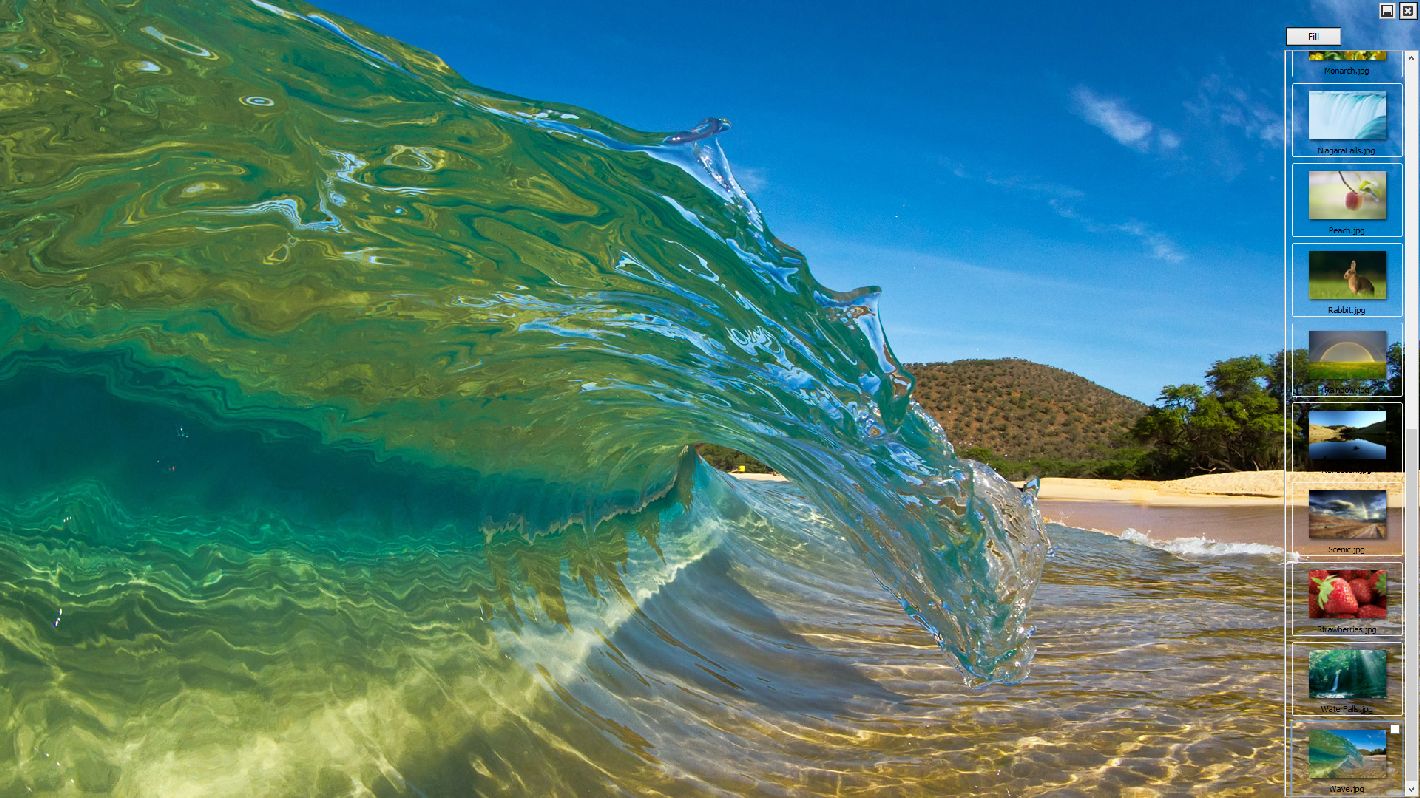
TImageEnMView does not support transparency which is a "show stopper" when creating an application that uses transparent panels placed on top of TImageEnView to hold various controls including ImageEnMView. Over the last several weeks I have searched extensively for a thumbnail component that supports transparency for a clients application and was unable to find one. I also tried various skinning components to achieve transparency, but those attempts failed as well. After much thought and experimentation I was finally able to achieve an illusion of transparency with TImageEnMView. I decided to release a free demo to show ImageEn Developers how this can be accomplished because I spent so much time and research trying to render TImageEnView "transparent".
This demo illustrates how to achieve an illusion of transparency with TImageEnMView. This provides a satisfactory illusion that mageEnMView is 100% transparent when actually it is not transparent at all. This demo uses a TImageEnView client aligned to the form. A TPanel is placed on TImageEnView and is aligned to the right. A TImageEnMView is placed on the TPanel. An illusion of transparency can be achieved by creating a bitmap from the image loaded into TImageEnView by using a portion of the TImageEnView.Bitmap as wallpaper for TImageEnMView.
The original code used ImageEnView1.CopySelectionToBitmap to load the wallpaper. The revised code to load the wallpaper was developed by Nigel Cross and it uses PaintToEx and CopyRect to obtain a bitmap of the image under the TImageEnMView. This improved code is faster than the original code, eliminates the need to use a selection and works at all zoom levels.
Source:
./attach/w2m/201485105122_AssignWallpaper.zip
Bill Miller
Adirondack Software & Graphics
Email: w2m@hughes.net
EBook: http://www.imageen.com/ebook/
Custom Commercial ImageEn Development |
 |
|
|
spetric
  
Croatia
308 Posts |
 Posted - Sep 02 2014 : 04:54:36 Posted - Sep 02 2014 : 04:54:36


|
Polyline simplification/spline drawing
Here is one simple demo showing the usage of Douglas-Peucker polyline simplification algorithm and Catmull-Rom spline drawing.
After free-hand polyline is drawn in ImageEnVect (miPutPolyLine), you can simplify polyline by pressing "Simplify" button, or construct spline curve by pressing "Spline" button.
NOTE: Spline curve is constructed from simplified polyline, ie. simplification is automatically performed prior to spline drawing.
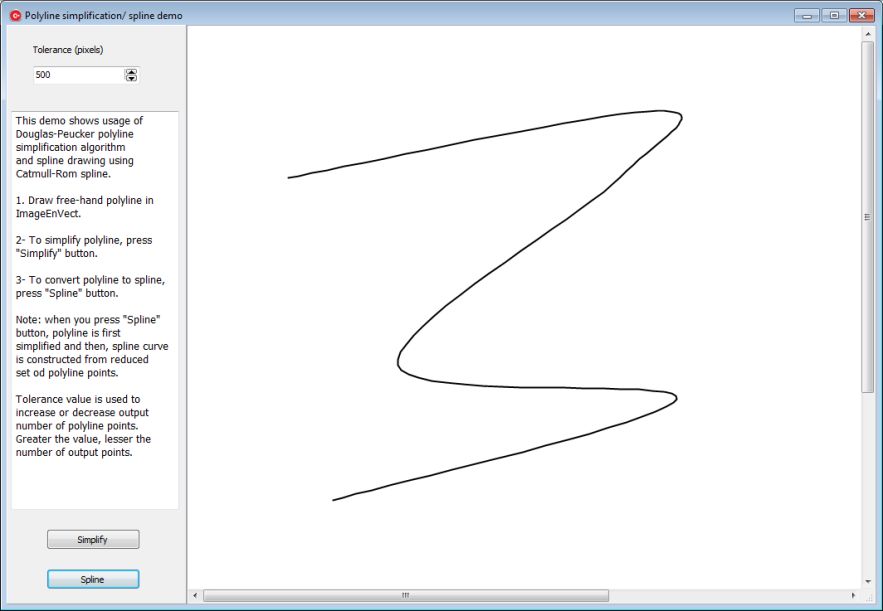
Here is the source code in XE5 C++, but it can be easily ported to Delphi:
./attach/spetric/20149253344_ien_spline_source.zip
Here is BCB6 version source code, with demo exe (it fit into 2M limit) :
./attach/spetric/201492123912_ien_spline_bcb6.zip
There is a little difference between XE5 and BCB6 code, because in XE5 I use ImageEn 5.1.1 and in BCB6 ImageEn 3.0.2. The difference is in polyCount number :) |
 |
|
|
rmklever
 
Norway
52 Posts |
 Posted - Jan 13 2015 : 20:35:34 Posted - Jan 13 2015 : 20:35:34


|
Voronoi FX
by Roy Magne Klever
Full source code and Exe demo
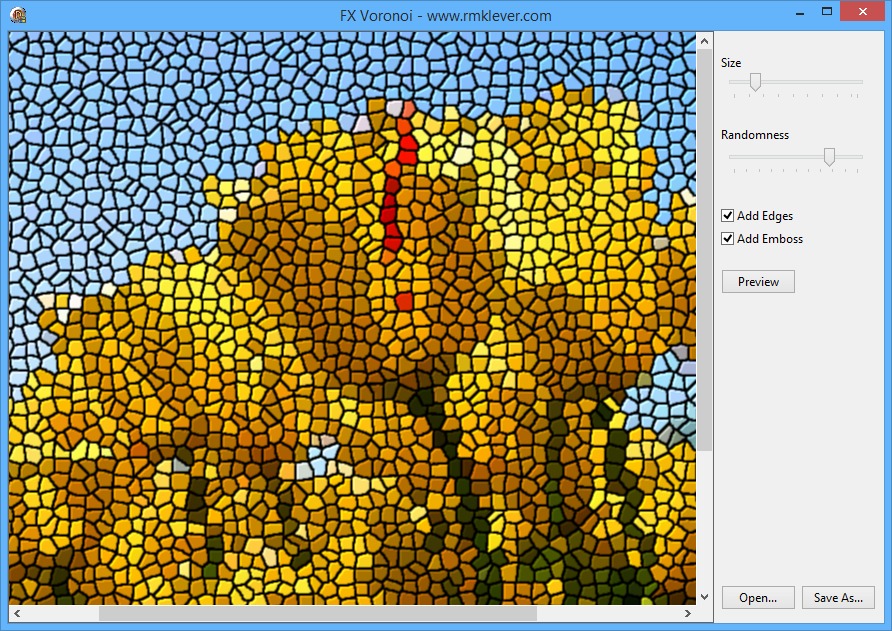
This is a sample of an fx effect using voronoi diagram. I think it is quite cool and work well as an fx.
I did use the "voronoi diagram in regular grid" lua script found in the Lua binding post by spetric to learn how to create a Voronoi diagram so cred to spetric for his contribution.
If you improve the effect regarding speed or result I sure would like to see it.
Enjoy and have fun:
Download: attach/rmklever/201511320043_FxVoronoi.zip
1904.55 KB
I do hope you find it interesting and useful.
Roy M Klever
Klever on Delphi - www.rmklever.com |
 |
|
|
xequte
    
38939 Posts |
|
|
Uwe
  
284 Posts |
 Posted - Jan 19 2015 : 17:38:33 Posted - Jan 19 2015 : 17:38:33


|
Great demo, Roy. Thanks for sharing.
Cheers
-Uwe |
 |
|
|
spetric
  
Croatia
308 Posts |
 Posted - Feb 26 2015 : 14:41:11 Posted - Feb 26 2015 : 14:41:11


|
Hi Roy,
Great mosaic fx! I have extended "Voronoi diagram in regular grid" scrip to accept not only square grid, but also rectangular grid, where cells can also be shifted in order to create "brick-style" layout.
Because of this, I made a slightly modification in algorithm, in the part where neighboring cells are inspected (function find_closest). I have also added various intensity fall-off modes (lines 144 - 146).
Here is the script:
attach/spetric/2015226143851_voronoi_regular_grid.zip
2.16 KB
Here is an example (the bird on the bottom of the FB page https://www.facebook.com/Pixopedia):
https://www.facebook.com/Pixopedia/posts/816203735112862
I forgot something. A really cool enhancement in your demo would be to add multipass mosaik effect. The first pass goes with big size grid, let's say 60. The second pass goes with half size (30) and prior of drawing each "cell" checks average error inside new cell against some threshold value (difference between pixels of original image and image created in the first step). If average error is above specified threshold cell is drawn, otherwise not. The same thing goes for the third pass and so on.
Alternative solution, in one pass, is to perform some adaptive seeding (more points in areas with more "color changes") and then perform general Voronoi tessellation, using Fortune's algorithm. I think I saw Fortune's algorithm implementation in Delphi somewhere on the web. |
 |
|
|
rmklever
 
Norway
52 Posts |
 Posted - Mar 01 2015 : 15:38:40 Posted - Mar 01 2015 : 15:38:40


|
Hi Spetric,
Thanks for the updated script, it is very good.
I have updated the Voronoi demo to include some of your changes...
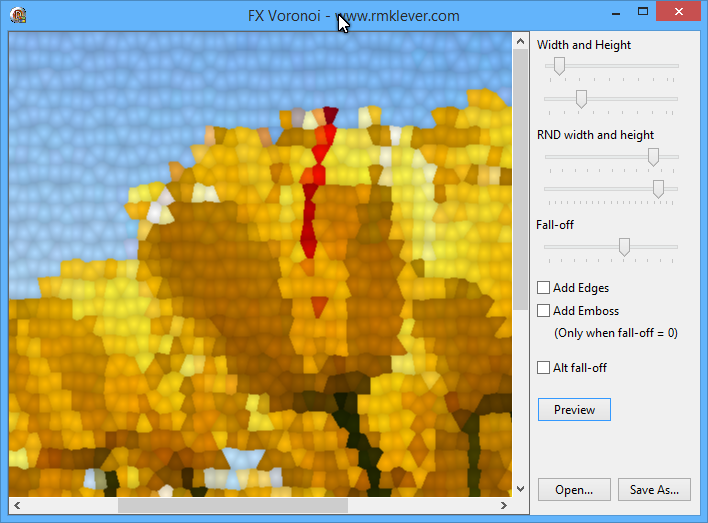
Spetric, you have some very nice effects in your program Pixopedia. I did not test it recently but on your FB pixopedia page you had a very great auto brush sample. We are doing much of the same stuff but I think you are a step in front of me. Good inspiration.
Regarding multipass fx, I do not have any idea of how to implement a multipass mosaic effect.. and I guess it would be quite messy too.
This demo is just a quick and dirty demo of some cool mosaic fx you can do using voronoi diagram. I built the effect on the script above by Spetric.
Here is the Delphi files and Exe so you can test it...
attach/rmklever/201531152424_FXVoronoi.zip
1963.19 KB
As usually I do hope you find it interesting and useful.
Roy M Klever
Klever on Delphi - www.rmklever.com |
 |
|
|
spetric
  
Croatia
308 Posts |
 Posted - Mar 02 2015 : 16:56:59 Posted - Mar 02 2015 : 16:56:59


|
Hi Roy,
Great work. I have also ported your curves tool (partially) to C++ and added possibility to apply curve through any shape (free hand stroke, ellipse, spline, text, etc...). Works like a charm.
Thanks,
Siniša |
 |
|
|
yogiyang
   
India
727 Posts |
 Posted - Mar 02 2015 : 22:15:49 Posted - Mar 02 2015 : 22:15:49


|
Spetric,
Are you going to share your handy work here?
Just curious to know.
On your web site I found the tool NiGulp. It allows one to use Photoshop filters! That is great. Can you share as to how you managed to achieve this and whether the software is developed 100% in Delphi or some other language.
I am personally looking for a way to load Photoshop filters in the software that I am developing so I am very much interested in knowing as to how you manage to load and handle Photoshop filters.
Regards,
Yogi Yang
Yogi Yang |
 |
|
|
spetric
  
Croatia
308 Posts |
 Posted - Mar 03 2015 : 01:42:36 Posted - Mar 03 2015 : 01:42:36


|
Hi Yogi,
Unfortunately, I do not program in Delphi, but in C++.
I have posted a link to static library for Photoshop host, but I must check if link still exists (my site was compromised and I was forced to reset complete site). If it does not exists, I will upload it again.
However, there is another source code based on it (with Delphi "headers"):
http://meesoft.logicnet.dk/
Check the paragraph "8fb Plugin Interface".
HTH,
Siniša |
 |
|
|
spetric
  
Croatia
308 Posts |
 Posted - Mar 07 2015 : 16:07:27 Posted - Mar 07 2015 : 16:07:27


|
Done!
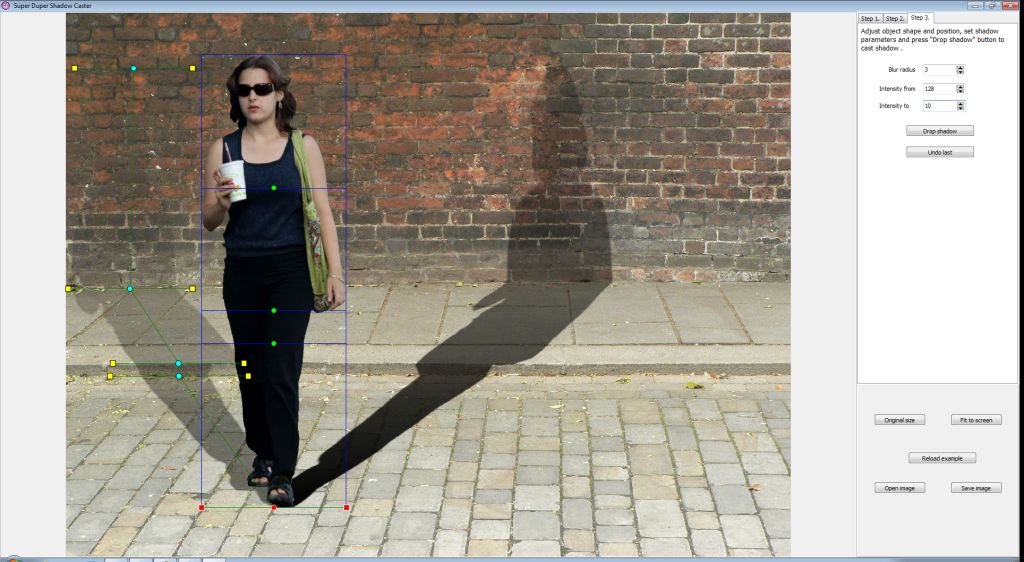
I hope I packed it correctly. Here is a demo exe of shadow caster program (Super Duper Shadow Caster) with source code (C++). Example included:
attach/spetric/2015392583_shadow_caster_distrib.zip
3999.55 KB (updated)
When program is started, example image is loaded.
To get a first impression, follow these steps:
1. Press "Load example selection" button and proceed to Step 2. (tab)
2. Press "Create shadow control" and proceed to Step 3. (tab)
3. Press "Drop shadow" button. Shadow is drawn (I hope so).
4. Press "Undo last" button to undo last operation.
5. Set blur radius to some value, set different intensity values and pefrom "Drop shadow" again to see the difference.
Now, you can go back to Step 2. and increase number of folding lines.
Create new set of shadow controls, go to Step 3. and move lines across the image. When mouse is over control point, cursor changes to hand-point. Drag control points around to cast different type of shadows. You can cast multiple shadows as well (one by one).
Note:
In Step 1. you can only draw lasso selection with mouse.
In Step 2. you can only pan image with mouse.
In Step 3. you can only move control points.
If there are some problems with demo, please let me know.
Good luck,
Siniša
Edit: blur radius is actually obsolete, as same thing can be achieved with feather value. Also, using feather value will adjust source rectangle size, while blurring the mask will leave it as is, which yields to cutting of blurred part of mask on the source rectangle border. Maybe to add mask downsizing according to blur radius.
Newest version:
attach/spetric/201539164127_shadow_caster_distrib.zip
5092.06 KB
|
 |
|
|
w2m
   
USA
1990 Posts |
 Posted - Mar 08 2015 : 17:43:39 Posted - Mar 08 2015 : 17:43:39


|
GDIPlus Image Drawing
by William Miller/Adirondack
Full Source
Compiled with DelphiXE7, but is expected to compile with Delphi 2010 or higher.
Price: Free
GDIPlus Image Drawing features drawing pixels, ellipse brush, rectangle brush, opacity, transparency, rectangles, filled rectangles, round rectangles, filled round rectangles, ellipses, filled ellipses, erase brush, drawing lines, filling alpha and filling color using GDIPlus and layers. The demo shows how to draw and how to use backbuffer drawing with all of the above tools with GDI plus and ImageEn.
Only ImageEn and standard Vcl controls were used in the demo. The brush drawing tools are not threaded so they are not nearly as fast as commercial products such as the Paint Engine that has improved painting functionality and threading for ImageEn by www.nwscomps.com.
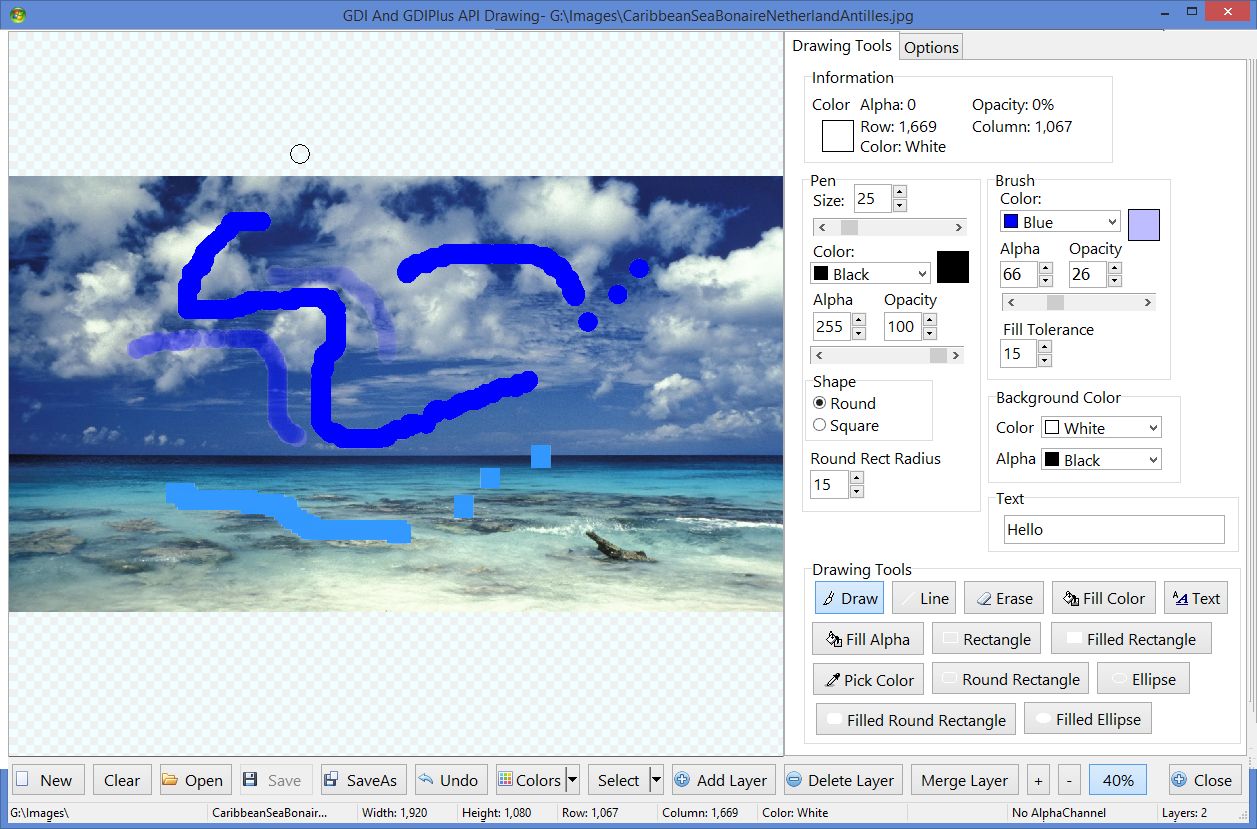
Source Code:
attach/w2m/20153817538_GDIPlusImageMaker.zip
106.67 KB
William Miller
Adirondack Software & Graphics
Email: w2m@hughes.net
EBook: http://www.imageen.com/ebook/
Apprehend: http://www.frontiernet.net/~w2m/index.html
Custom ImageEn Development |
 |
|
 Topic Topic  |
|